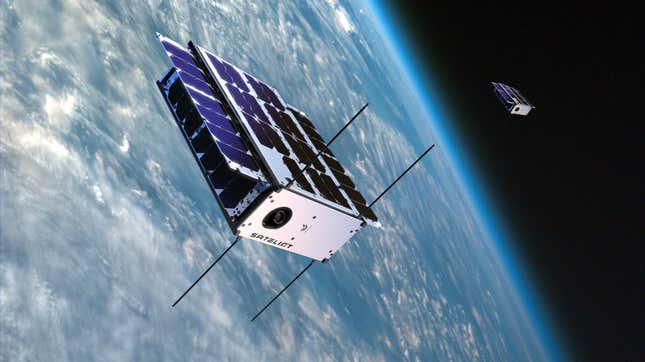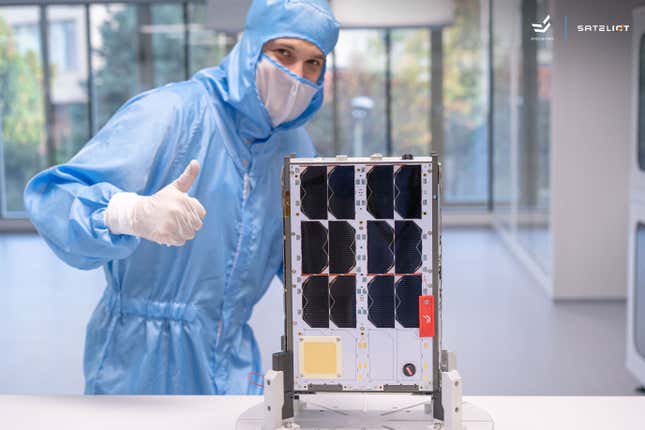
A SpaceX Falcon 9 rocket launched “The GroundBreaker” satellite this weekend in a shared mission with Spanish company Sateliot. GroundBreaker is the first satellite with standard 5G technology in low Earth orbit, and the first piece of a future constellation of 250 nanosatellites that aims to offer 5G connectivity from space for Internet of Things devices.
Weighing just 22 pounds (10 kilograms), GroundBreaker is poised to offer coverage to areas three times the size of Texas. Manufactured by the Bulgarian CubeSat and NanoSat specialist EnduroSat, the satellite boasts an integrated module that provides a direct connection to devices with NB-IoT, a specific IoT network. Any IoT device with 5G support that’s updated to the Rel-17 NTN standard can connect to the 5G offered by the satellite. In recent years, Sateliot has contributed greatly to this standard, primarily due to a previous satellite the company launched in 2021.

In an email to Gizmodo, Sateliot CEO Jaume Sanpera claims his company has contributed the most to the Rel-17 NTN standard. “We can say that we’ve developed the new standard at the same time we developed the technology to connect devices to the satellite,” Sanpera said, adding that he felt immense pride and satisfaction for the work done by company prior to the launch.
How does Sateliot’s GroundBreaker satellite work?
The GroundBreaker operates on the 5G common standard frequencies S and L. Sateliot hopes the satellite can help companies in a variety of sectors, from logistics and agriculture to marine transport and rail, and allow users to switch from terrestrial 5G networks to non-terrestrial networks without having to buy additional hardware, such as antennas or modems.
Sateliot has partnered with Spanish telecommunications giant Telefonica to demonstrate the capacity of its proposed roaming system. In the test, Sateliot will connect a 5G IoT device to one of the operator’s terrestrial antennas. It will then move to an area without data coverage. If everything turns out as planned, the system will still be able to send messages in roaming mode with the transparent connection between the device and the satellite.
Sateliot launched its GroundBreaker satellite through SpaceX’s rideshare program
Sateliot employees in the company’s Barcelona and San Francisco offices had to set up three consecutive meetings to watch the launch, which was postponed several times because of the weather. SpaceX’s Transporter-7 mission finally launched at 2:48 a.m. ET on Saturday from the Vandenberg Space Force Base in California. Onboard, it carried 51 payloads, including Kenya’s first operational nanosatellite and asteroid mining company AstroForge’s pathfinding spacecraft.
Shared missions in SpaceX’s rideshare program begin at $275,000, but in the case of Transporter-7, the average cost for a lift rose to $1 million. The Sateliot GroundBreaker was sent to space connected to a box-shaped deployer, which serves as an orbital placement system aboard the rocket. The deployer is equipped with mechanisms that will now propel the satellite to its operational orbit.
What’s next for Sateliot’s GroundBreaker satellite?

Sanpera told Gizmodo that the GroundBreaker has a four-week commission period during which the team will carry out tests to verify that the satellite is receiving energy from its solar panels and that the panels are working correctly. At the same time, it will perform checks to ensure the rest of the GroundBreaker’s systems are good to go. Sateliot can’t declare the satellite as operational until after the four weeks have passed, the CEO said.
“Before the end of the year, we plan to launch four more satellites that together will become our first commercial constellation in space,” Sanpera said. “We expect to begin providing coverage throughout the world at the beginning of next year.”
However, launching 250 nanosatellites before 2026, including the five slated for this year and 60 next year, isn’t the most ambitious part of Sateliot’s plan. The company is aiming to bring in more than $1 billion in revenue and more than $406 million in EBITDA this year by providing coverage to companies across the world. Its goal: to eliminate the idea that satellite internet is expensive. Well, at least coverage for Internet of Things devices.
For more spaceflight in your life, follow us on Twitter and bookmark Gizmodo’s dedicated Spaceflight page.

